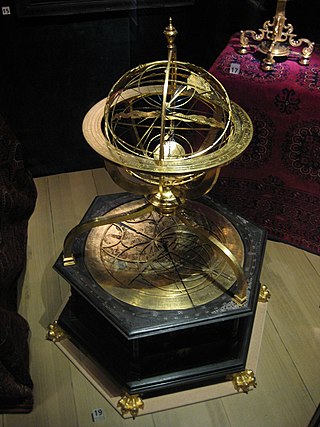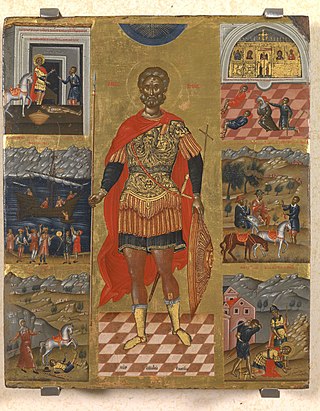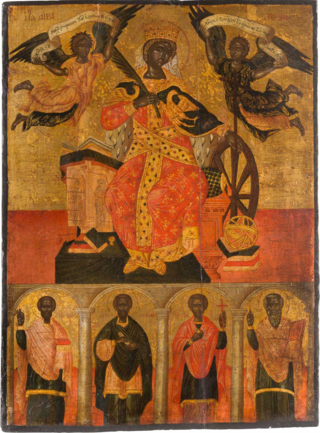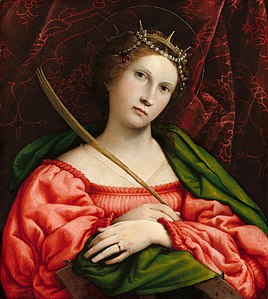
Hipparchus was a Greek astronomer, geographer, and mathematician. He is considered the founder of trigonometry, but is most famous for his incidental discovery of the precession of the equinoxes. Hipparchus was born in Nicaea, Bithynia, and probably died on the island of Rhodes, Greece. He is known to have been a working astronomer between 162 and 127 BC.

The zodiac is a belt-shaped region of the sky that extends approximately 8° north and south of the ecliptic, which is the apparent path of the Sun across the celestial sphere over the course of the year. The orbital paths of the Moon and major planets are within the belt of the zodiac.
Hypatia was a neoplatonist philosopher, astronomer, and mathematician who lived in Alexandria, Egypt, then part of the Eastern Roman Empire. She was a prominent thinker in Alexandria where she taught philosophy and astronomy. Although preceded by Pandrosion, another Alexandrine female mathematician, she is the first female mathematician whose life is reasonably well recorded. Hypatia was renowned in her own lifetime as a great teacher and a wise counselor. She wrote a commentary on Diophantus's thirteen-volume Arithmetica, which may survive in part, having been interpolated into Diophantus's original text, and another commentary on Apollonius of Perga's treatise on conic sections, which has not survived. Many modern scholars also believe that Hypatia may have edited the surviving text of Ptolemy's Almagest, based on the title of her father Theon's commentary on Book III of the Almagest.

An astrolabe is an astronomical instrument dating back to ancient times. It serves as a star chart and physical model of visible heavenly bodies. Its various functions also make it an elaborate inclinometer and an analog calculation device capable of working out several kinds of problems in astronomy. In its simplest form it is a metal disc with a pattern of wires, cutouts, and perforations that allows a user to calculate astronomical positions precisely. Historically used by astronomers, it is able to measure the altitude above the horizon of a celestial body, day or night; it can be used to identify stars or planets, to determine local latitude given local time, to survey, or to triangulate. It was used in classical antiquity, the Islamic Golden Age, the European Middle Ages and the Age of Discovery for all these purposes.

Catherine of Alexandria, also spelled Katherine is, according to tradition, a Christian saint and virgin, who was martyred in the early fourth century at the hands of the emperor Maxentius. According to her hagiography, she was both a princess and a noted scholar who became a Christian around the age of 14, converted hundreds of people to Christianity and was martyred around the age of eighteen. More than 1,100 years after Catherine's martyrdom, Joan of Arc identified her as one of the saints who appeared to and counselled her.

An armillary sphere is a model of objects in the sky, consisting of a spherical framework of rings, centered on Earth or the Sun, that represent lines of celestial longitude and latitude and other astronomically important features, such as the ecliptic. As such, it differs from a celestial globe, which is a smooth sphere whose principal purpose is to map the constellations. It was invented separately first in ancient China during the 4th century BC and ancient Greece during the 3rd century BC, with later uses in the Islamic world and Medieval Europe.
Theon of Alexandria was a Greek scholar and mathematician who lived in Alexandria, Egypt. He edited and arranged Euclid's Elements and wrote commentaries on works by Euclid and Ptolemy. His daughter Hypatia also won fame as a mathematician.

Saint Catherine's Monastery, officially the Sacred Autonomous Royal Monastery of Saint Katherine of the Holy and God-Trodden Mount Sinai, is a Christian monastery located in the Sinai Peninsula of Egypt. Located at the foot of Mount Sinai, it was built between 548 and 565, and is the world's oldest continuously inhabited Christian monastery.

The triquetrum was the medieval name for an ancient astronomical instrument first described by Ptolemy in the Almagest. Also known as Parallactic Rulers, it was used for determining altitudes of heavenly bodies. Ptolemy calls it a "parallactic instrument" and seems to have used it to determine the zenith distance and parallax of the Moon.

Ancient Greek astronomy is the astronomy written in the Greek language during classical antiquity. Greek astronomy is understood to include the Ancient Greek, Hellenistic, Greco-Roman, and late antique eras. It is not limited geographically to Greece or to ethnic Greeks, as the Greek language had become the language of scholarship throughout the Hellenistic world following the conquests of Alexander. This phase of Greek astronomy is also known as Hellenistic astronomy, while the pre-Hellenistic phase is known as Classical Greek astronomy. During the Hellenistic and Roman periods, many of the Greek and non-Greek astronomers working in the Greek tradition studied at the Museum and the Library of Alexandria in Ptolemaic Egypt.

Cretan School describes an important school of icon painting, under the umbrella of post-Byzantine art, which flourished while Crete was under Venetian rule during the Late Middle Ages, reaching its climax after the Fall of Constantinople, becoming the central force in Greek painting during the 15th, 16th and 17th centuries. The Cretan artists developed a particular style of painting under the influence of both Eastern and Western artistic traditions and movements; the most famous product of the school, El Greco, was the most successful of the many artists who tried to build a career in Western Europe, and also the one who left the Byzantine style farthest behind him in his later career.

Egyptian astronomy began in prehistoric times, in the Predynastic Period. In the 5th millennium BCE, the stone circles at Nabta Playa may have made use of astronomical alignments. By the time the historical Dynastic Period began in the 3rd millennium BCE, the 365 day period of the Egyptian calendar was already in use, and the observation of stars was important in determining the annual flooding of the Nile.

The Church of Sinai is a Greek Orthodox autonomous church whose territory consists of St. Catherine's Monastery at the foot of Mount Sinai in Egypt, along with several dependencies. There is a dispute as to whether the church is fully autocephalous or merely autonomous. The church is headed by the Archbishop of Mount Sinai and Raithu, who is traditionally consecrated by the Greek Orthodox Patriarch of Jerusalem and also serves as abbot for the monastery. The current hierarch is Archbishop Damian.

Ieremias Palladas, also known as PouladasIeremia Pallada. He was a Greek Renaissance painter. He was a clergyman, painter, and educator. He was affiliated with Saint Catherine's Monastery in Mount Sinai, Egypt. He is one of the most notable Greek painters of the 17th century. His family consisted of clergy and painters. His nephew was Patriarch of Alexandria Gerasimos Palladas. His work was influenced by Nikolaos Tzafouris and Angelos Akotantos. Georgios Klontzas and Emmanuel Lambardos were active in Crete around the same period. Palladas influenced the works of Theocharis Silvestros, Iakovos Moskos, Ioannis Kornaros and Philotheos Skoufos. According to the Institute of Neohellenic Research, twenty-four of his works survived. His specialty was painting crosses for the iconostasis or templo. Most of his works are in Egypt.

Theocharis Silvestros was a Greek Baroque painter. He was a monk affiliated with Saint Catherine's Monastery Mount Sinai, Egypt. He was also active in Heraklion Crete. He was influenced by famous painters Emmanuel Lambardos and Ieremias Palladas. Theocharis was a renowned painter of the Cretan School. He influenced countless Greek painters. He was active during the same period as Philotheos Skoufos and Franghias Kavertzas. His most notable works are of Catherine of Alexandria. Most of his remaining works are associated with Saint Catherine's Monastery Mount Sinai, Egypt. He was a Sinaitic monk.

Saint Catherine is a tempera painting created by Ieremias Palladas. Palladas was a Greek painter from Crete. He was a Sinaitic monk. He was associated with Saint Catherine's sacred monastery in Egypt also known as Mount Sinai. The monastery is at the location where Mosses received his tablets. There was a dependency of the monastery in Heraklion, Crete by the same name. Palladas completed works for the monastery in Egypt. He also created works for the Holy Sepulture in Jerusalem and a church in Bethlehem, Israel. His version of the martyr became the framework of Cretan paintings of Saint Catherine. Another Sinaitic monk named Theocharis Silvestros worked with Palladas. He also created notable versions of Saint Catherine around the same period.

The Virgin of the Burning Bush was a painting made of egg tempera and gold leaf on a wood panel. The portable icon was signed by Greek painter Michael Damaskinos. Damaskinos has over 100 known works. He was a distinguished member of the Cretan school of painting. He was from Crete. His contemporaries included Georgios Klontzas and El Greco. Damaskinos spent over twenty years traveling all over Italy. He spent a significant time in Venice. He adopted Italian artistic mannerisms which he applied to his paintings.

The Hipparchus star catalog is a list of at least 850 stars that also contained coordinates of stellar positions in the sky, based on celestial ecliptic latitude and longitude. According to British classcist Thomas Heath, Hipparchus was the first to employ such a method to map the stars, at least in the West. Hipparchus is also credited with creating a celestial globe, although this object is not known to be extant. The catalog was lost to history, until parts of it were rediscovered in 2022 in the Codex Climaci Rescriptus, an ancient palimpsest found in Saint Catherine's Monastery on Mount Sinai.

Transfiguration and Monastic Scenes is a multi-themed tempera painting created by Greek painter Georgios Klontzas. Klontzas was a Cretan Renaissance painter. The artist was hired to assess work completed by El Greco. Klontzas was from a wealthy family and owned a successful workshop in the center of Crete. His existing catalog consists of Fifty-four works. He completed incredible triptychs and manuscripts. Klontzas and Micheal Damaskinos are two of the most prominent Greek painters of the 16th century due to the size of their catalogs and the popularity of their works excluding El Greco.

Christ Pantocrator is a tempera painting created by Ieremias Palladas. Ieremias was associated with Saint Catherine's sacred monastery in Egypt also known as Mount Sinai. He was a Sinaitic monk, painter, and teacher. His nephew Gerasimos Palladas became the Patriarch of Alexandria. There was a dependency of Saint Catherine's Monastery which was in Mount Sinai, Egypt on the island of Crete which was called Saint Catherine's Monastery of Heraklion. The site in Egypt was believed by Christians to be the site where Moses saw the burning bush. The Patriarch of Jerusalem Nectarius wrote about the painter in his archives because Ieremias was one of the most influential figures of his time.
























